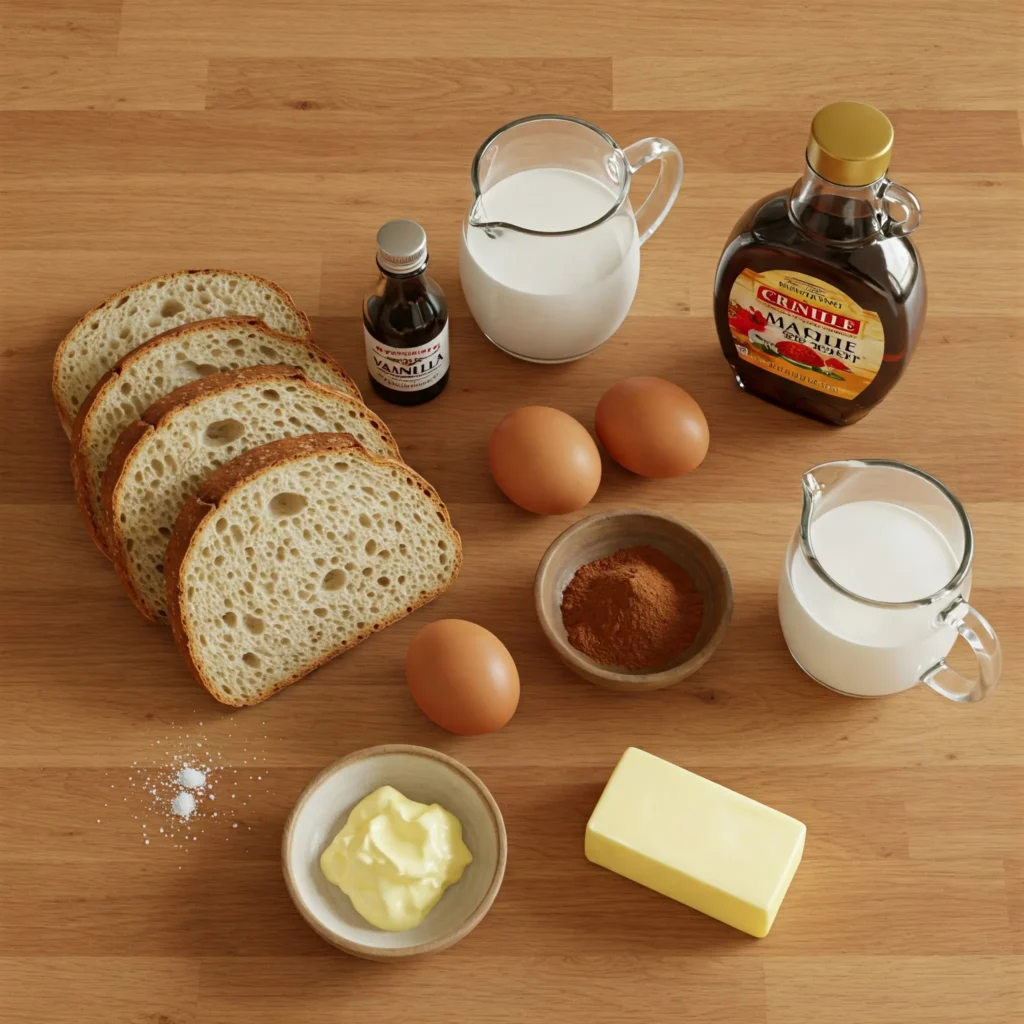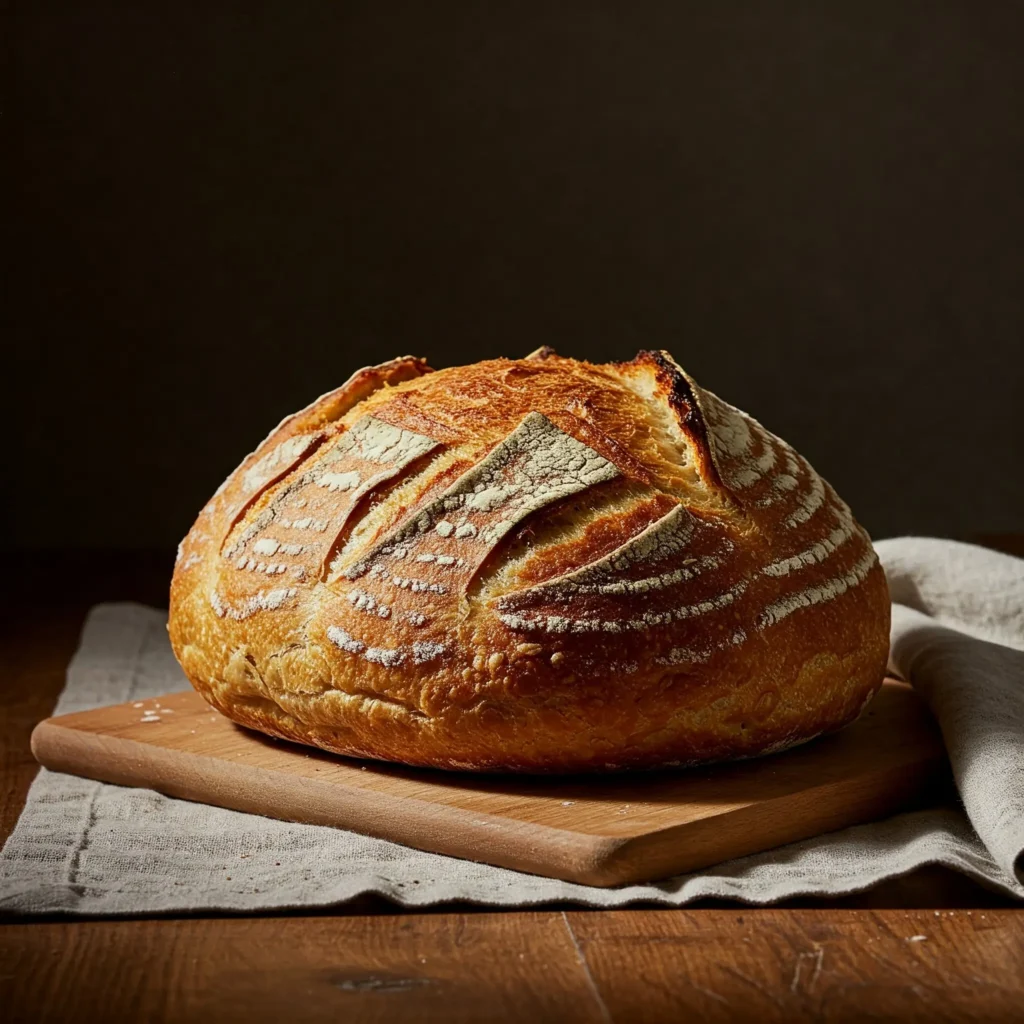Sourdough French Toast Recipe: A Game Changer
French toast is already amazing—but have you ever tried it with sourdough? That little bit of tang in the bread balances out the rich, creamy goodness from the eggs and milk, creating layers of flavor. Instead of being just sweet and heavy, it has depth and contrast.

The texture is another major upgrade. No soggy slices here. Sourdough holds up beautifully, soaking in just the right amount of custard while staying firm enough to get perfectly crispy, golden edges and a soft, custardy center.
And then there’s the flavor. Regular bread just can’t compete. Sourdough’s natural fermentation gives it a subtle complexity—a little tangy, a little nutty, just the right amount of chew. Add maple syrup, fresh berries, or a sprinkle of cinnamon sugar, and suddenly, your French toasts go from good to unforgettable.
This guide covers everything you need—why sourdough is the ultimate choice, the best techniques for that flawless texture, and, of course, some delicious recipes to take your breakfast to the next level.
Quick Recipe at a Glance
Ingredients:
- 4 thick slices of sourdough bread
- 2 large eggs
- 1/2 cup whole milk (or a milk alternative)
- 1 teaspoon vanilla extract
- 1 teaspoon cinnamon
- 1 tablespoon maple syrup or honey
- 1/4 teaspoon salt
- 1 tablespoon butter (for cooking)

Instructions:
- Whisk eggs, milk, vanilla, cinnamon, maple syrup, and salt in a shallow bowl.
- Dip each slice of sourdough into the custard for about 30 seconds per side.
- Heat butter in a skillet over medium heat and cook each slice for 2-3 minutes per side until golden brown.
- Serve with fresh fruit, syrup, or your favorite toppings.
The History of French Toast and Sourdough
French toast has been enjoyed for centuries, dating back to ancient Rome, where it was known as “pan dulcis.” Soaking stale bread in milk and eggs before frying was a practical way to use leftovers and create a hearty meal. Over time, the dish spread across Europe and beyond, taking on different names and variations in each culture.

Sourdough bread has an even older history, dating back thousands of years. It was the primary form of leavened bread before commercial yeast became widely available. The natural fermentation process gives sourdough its distinct tang and makes it easier to digest compared to conventional bread. Combining these two traditions results in a dish that is both flavorful and historically rich.
Why Sourdough Bread is Perfect for French Toast
Sourdough bread has several characteristics that make it ideal for French toast:
- Sturdy Texture: Sourdough’s chewy crumb holds up well when soaked in the custard mixture.
- Unique Flavor Profile: The tanginess of sourdough pairs perfectly with sweet and savory toppings.
- Nutritional Benefits: Sourdough fermentation breaks down gluten and phytic acid, making it easier to digest than regular bread.
Variations and Toppings
Sweet Variations
- Berry Bliss: Top with mixed berries, honey, and a dollop of Greek yogurt.
- Chocolate Lover’s Delight: Add chocolate chips to the custard mix and drizzle with chocolate sauce.
- Caramelized Banana: Fry banana slices in butter and brown sugar, then serve over French toast.
Savory Variations
- Avocado & Egg: Top with smashed avocado, a poached egg, and a sprinkle of chili flakes.
- Bacon & Cheese: Add crispy bacon and shredded cheddar for a savory twist.
- Herb & Ricotta: Spread ricotta cheese and sprinkle with fresh herbs and black pepper.

Tips for the Perfect Sourdough French Toast
- Use Day-Old Bread: Slightly stale sourdough absorbs the custard better without falling apart.
- Adjust Soaking Time: Thick slices need more time to soak, while thinner slices require less.
- Control Heat: Medium heat prevents burning while ensuring the center is fully cooked.
- Experiment with Spices: Nutmeg, cardamom, or allspice can elevate the flavor.
Nutritional Benefits of Sourdough French Toast
Compared to traditional French toast, sourdough offers:
- Improved Digestibility: The fermentation process reduces gluten content.
- Lower Glycemic Index: Sourdough digests more slowly, leading to steadier blood sugar levels.
- Rich in Probiotics: Naturally occurring lactobacilli promote gut health.
Digestive Benefits of Sourdough
Sourdough bread is easier to digest compared to regular bread due to its natural fermentation process. Here’s why it stands out:
- Lower Gluten Content – Fermentation breaks down some gluten, making it gentler on digestion.
- Rich in Prebiotics & Probiotics – Sourdough contains beneficial bacteria that support gut health.
- Less Phytic Acid – The process reduces phytic acid, improving nutrient absorption.
- Stable Blood Sugar Levels – The slow fermentation leads to a lower glycemic index, preventing sugar spikes.

Common Mistakes to Avoid
- Using Fresh Bread: Fresh sourdough can become too mushy when soaked.
- Not Mixing the Custard Well: Ensure eggs and milk are fully combined for even cooking.
- Overcrowding the Pan: Cook in batches to maintain even browning.
- Skipping the Rest Time: Allow the toast to sit for a minute after cooking for the best texture.
Sourdough French Toast Around the World
French toast exists in many cultures, often with unique twists:
- Pain Perdu (France): A rich version soaked in cream and sugar before frying.
- Torrijas (Spain): Soaked in sweet wine and sprinkled with cinnamon sugar.
- Hong Kong-Style French Toast: Deep-fried and filled with peanut butter or kaya jam.
- Arme Ritter (Germany): A denser, eggier version often served with jam.

Making Sourdough French Toast for Any Occasion
Breakfast & Brunch
- Serve with fresh fruit, granola, and a drizzle of honey.
- Pair with coffee or a mimosa for a complete brunch experience.
Dessert
- Turn it into a decadent treat with ice cream and caramel sauce.
- Layer with mascarpone and berries for a French toast trifle.
Special Occasions
- Holiday Brunch: Add festive spices like nutmeg and cloves.
- Birthday Treat: Use chocolate sourdough for an indulgent twist.
FAQs About Sourdough French Toast
1. Can I use fresh sourdough bread?
Yes, but day-old or slightly stale sourdough works best as it absorbs the custard without becoming too mushy.
2. Can I make this recipe dairy-free?
Absolutely! Substitute whole milk with almond, oat, or coconut milk and use dairy-free butter or oil for cooking.
3. How do I prevent my French toast from being soggy?
Make sure not to over-soak the bread and cook over medium heat to ensure the inside cooks through without burning the outside.
4. Can I prepare sourdough French toast in advance?
Yes! You can soak the bread ahead of time and refrigerate it overnight. You can also freeze cooked French toast and reheat it in a toaster or oven.
5. Is there a way to make it healthier?
Use whole grain sourdough, reduce added sugar, and top with fresh fruit and nuts instead of syrups.
6. Can I bake instead of fry my French toast?
Yes! Arrange soaked bread on a greased baking sheet and bake at 375°F (190°C) for 10-15 minutes per side until golden and crispy.
7. What is the best bread for French toast?
The best bread for French toast is sturdy, slightly stale, and has a good crumb structure to absorb the custard. Sourdough, brioche, and challah are top choices, but sourdough stands out for its tangy flavor and firm texture.
Final Thoughts
Sourdough French toast is more than just a breakfast dish—it’s a versatile, flavorful, and nutritious meal that can be adapted to suit any taste. Whether you prefer it sweet, savory, or somewhere in between, mastering this dish will elevate your brunch game. Give it a try, and don’t forget to experiment with different toppings and flavors to make it your own.
Have you tried making sourdough French toast? Share your favorite variations and tips in the comments below.



